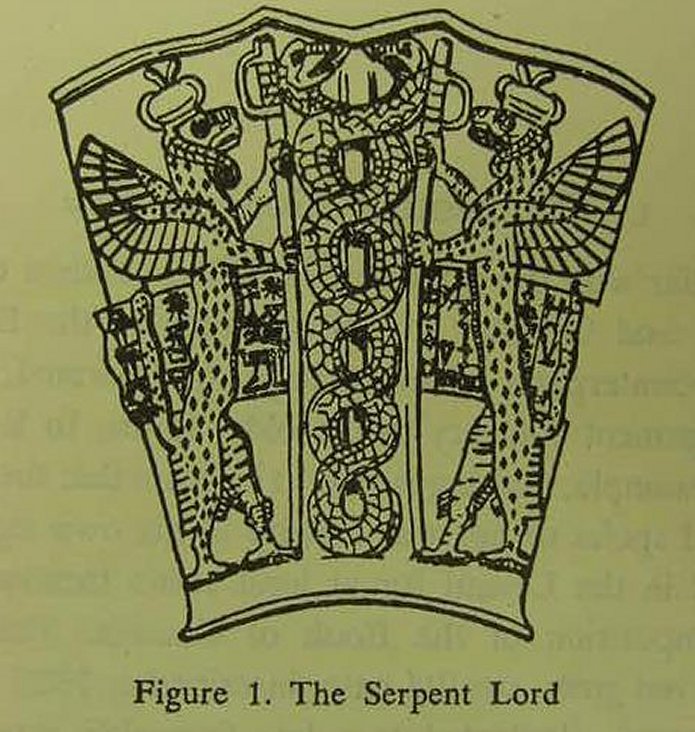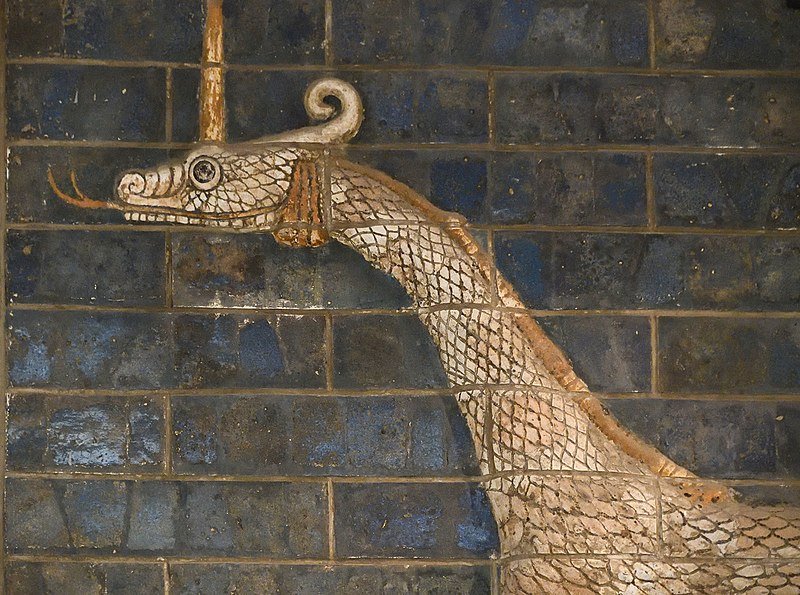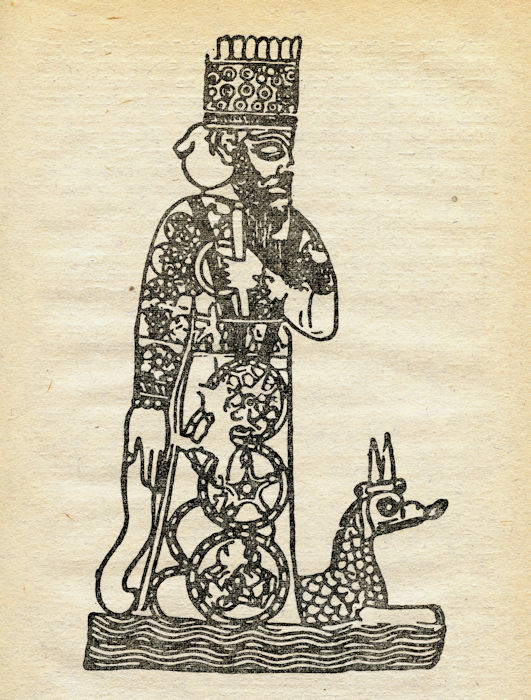Sirrush – Powerful “Glamorous Snake” Guarded Marduk But Did This Hybrid Really Exist?
A. Sutherland - AncientPages.com - Sirrush (Mushrush, Mushrushu) is a hybrid creature depicted on the Ishtar gate in Babylon. It resembles a dragon or a griffin, and it is the most famous image of this creature, displayed on the walls and gates of the procession path in Babylon.
Ningizzida in the middle, followed by the dragon Mushussu. Stone vase work "libation vase of Gudea". Image source - Public Domain
Sirrush has a horned snakehead, a scaly snake body, a long neck, a long tail, and scales. The slim scaly neck has the head of a serpent with a horn and a long forked tongue.
Because the tiles show a side view, only one horn can be seen, but two horns are clearly shown in other depictions. Flaps of skin cover the ears.
The creature's feet were remarkable and somewhat unusual. The forefeet being those of a feline, perhaps a leopard or a panther. On the other hand, the hind feet were large and birdlike, with four toes covered with scales.
This animal is identical to the dragons guarding Marduk and is considered one of his symbols.
The name 'sirrush' originates from the Akkadian word, roughly translated as a 'magnificent serpent.' The early researchers probably misread the title, and since then, "sirrush" has been used as the most common name for this creature. Other variations of its name include Mushussu ("the furious snake"), Musrussu dragon, and Sirrušu.
Mušḫuššu dragon in Istanbul Ancient Orient Museum Ishtar Gate. Image credit: Dosseman - CC BY-SA 4.0
The German archaeologist Robert Koldewey, who found the Ishtar Gate during his excavations from 1899 until 1917, was convinced that the 'Sirrush' existed.
He argued that in terms of the uniformity of his physiological concept, 'Sirrush' significantly surpasses all other legendary creatures.
The fact that 'Sirrushi' was depicted next to real animals (for example, lions), according to Koldewey, proved that the Babylonians were familiar with this creature, mentioned in ancient Mesopotamian mythology. One theory suggested that the Babylonians could copy the appearance of the Sirrush from the remains of prehistoric lizards, mainly because the animal resembles the so-called monitor lizards, which could be known to the Babylonians.
According to theories, the Sirrush's appearance was based on ancient stories about an animal that did not live in Mesopotamia.
According to written sources, the Sirrush was initially an animal of Ninazu, the god of Eshnunna (an ancient Sumerian and later Akkadian city and city-state in central Mesopotamia).
Marduk and his dragon Sirrush. Credit: Adobe Stock - Juulijs
In the Akkadian or early Babylonian times (18th century BC), this fantastic mythological hybrid animal was related to the god Tishpak, who replaced the guardian god of the city with this creature. In Lagash, on the other hand, he began to be associated with the son of Ninazu, the god Ningishida.
One of the most significant Babylonian-Assyrian gods, Nabu, was said to be the keeper of the tablet of fate regarding the ancient Babylonians and Assyrians.
He used to ride on a winged dragon known as Sirrush that initially belonged to his father, Marduk.
The Sirrush was referred to in Babylonian cuneiform inscriptions as Musrussu, meaning "Glamorous Snake" or "Splendor Serpent." The creature was identified with the mythical serpent-dragon mushkhushshu (or mushushu). This identification was significantly possible thanks to the texts from the inscriptions of King Nebuchadnezzar II.
These texts were devoted to construction work in Babylon conducted by this great ruler of ancient Babylonia and conquerer of Judah. With time, the Sirrush was transferred to Assyria and associated with the local state god Ashur, an equivalent of Enlil.
Written by – A. Sutherland - AncientPages.com Senior Staff Writer
Updated on May 6, 2024
Copyright © AncientPages.com All rights reserved. This material may not be published, broadcast, rewritten or redistributed in whole or part without the express written permission of AncientPages.com
Expand for referencesReferences:
Kriwaczek P., Babylon: Mesopotamia and the Birth of Civilization
Enthralling History, Ancient Mesopotamia
More From Ancient Pages
-
 Rare Ancient Clothes And Shoes Found Under The Ice At The Lost Lendbreen Mountain Pass
Featured Stories | Feb 9, 2023
Rare Ancient Clothes And Shoes Found Under The Ice At The Lost Lendbreen Mountain Pass
Featured Stories | Feb 9, 2023 -
 Mystery Of The Ancient Unknown Mining Civilization In North America – Connecting the Dots – Part 2
Civilizations | Apr 23, 2022
Mystery Of The Ancient Unknown Mining Civilization In North America – Connecting the Dots – Part 2
Civilizations | Apr 23, 2022 -
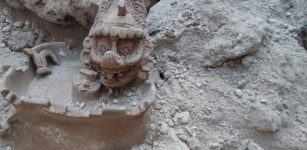 Unique Statue Of Mayan God K’awiil Associated With Lightning, Serpents, Fertility, Maize, Royal Lineage Found On Maya Train Route
Archaeology | May 17, 2023
Unique Statue Of Mayan God K’awiil Associated With Lightning, Serpents, Fertility, Maize, Royal Lineage Found On Maya Train Route
Archaeology | May 17, 2023 -
 Ancient Jaintia Kingdom And The Garden Of Monoliths And Dolmens
Featured Stories | Nov 8, 2016
Ancient Jaintia Kingdom And The Garden Of Monoliths And Dolmens
Featured Stories | Nov 8, 2016 -
 Stunning CGI Reconstruction Of Saint Thomas Becket’s Shrine
Archaeology | Jul 7, 2020
Stunning CGI Reconstruction Of Saint Thomas Becket’s Shrine
Archaeology | Jul 7, 2020 -
 Albert Pike’s Masonic Prophecy About The Three World Wars
Featured Stories | Jan 15, 2018
Albert Pike’s Masonic Prophecy About The Three World Wars
Featured Stories | Jan 15, 2018 -
 Riddle Of Mystery Hill: Who Built America’s Stonehenge?
Featured Stories | May 10, 2020
Riddle Of Mystery Hill: Who Built America’s Stonehenge?
Featured Stories | May 10, 2020 -
 On This Day In History: Treaty of Bergerac Ratified – On Sep 17, 1577
News | Sep 17, 2016
On This Day In History: Treaty of Bergerac Ratified – On Sep 17, 1577
News | Sep 17, 2016 -
 Huge Never-Before-Seen Ancient Petroglyphs Discovered In Kville, Bohuslän, Sweden
Archaeology | May 18, 2023
Huge Never-Before-Seen Ancient Petroglyphs Discovered In Kville, Bohuslän, Sweden
Archaeology | May 18, 2023 -
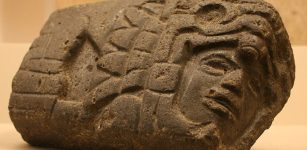 Sociopolitical Organization In Mesoamerica Influenced Developed Writing Systems And Communication
Archaeology | Feb 16, 2022
Sociopolitical Organization In Mesoamerica Influenced Developed Writing Systems And Communication
Archaeology | Feb 16, 2022 -
 Cooking Gear Found In Graves Of Viking Men And Women
Archaeology | Jun 27, 2019
Cooking Gear Found In Graves Of Viking Men And Women
Archaeology | Jun 27, 2019 -
 Mystery Of The Candelabrum: One Of The Most Enigmatic Ancient Giant Ground Drawings In The World
Featured Stories | Nov 2, 2015
Mystery Of The Candelabrum: One Of The Most Enigmatic Ancient Giant Ground Drawings In The World
Featured Stories | Nov 2, 2015 -
 The Oldest Denisovan Fossils Ever Discovered Shed New Light On Early Hominins As They Spread Across Eurasia
Archaeology | Nov 30, 2021
The Oldest Denisovan Fossils Ever Discovered Shed New Light On Early Hominins As They Spread Across Eurasia
Archaeology | Nov 30, 2021 -
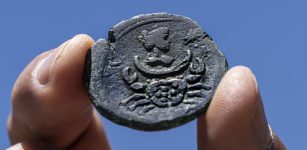 Rare 1,850-Year-Old Bronze Zodiac Coin Discovered During Underwater Survey Off Israel’s Coast
Archaeology | Jul 27, 2022
Rare 1,850-Year-Old Bronze Zodiac Coin Discovered During Underwater Survey Off Israel’s Coast
Archaeology | Jul 27, 2022 -
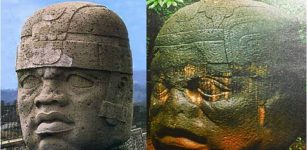 The Olmecs – Who They Were, Where They Came From Still Remains A Mystery
Civilizations | Feb 19, 2015
The Olmecs – Who They Were, Where They Came From Still Remains A Mystery
Civilizations | Feb 19, 2015 -
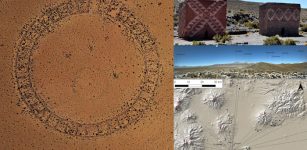 Mysterious Ancient Andean Waskiri Structure Built For Unknown Purpose Investigated By Scientists
Archaeology | Apr 14, 2023
Mysterious Ancient Andean Waskiri Structure Built For Unknown Purpose Investigated By Scientists
Archaeology | Apr 14, 2023 -
 Medieval Mythbusting – New Research Rewrites History Of Glastonbury Abbey
Archaeology | Nov 23, 2015
Medieval Mythbusting – New Research Rewrites History Of Glastonbury Abbey
Archaeology | Nov 23, 2015 -
 Historic Shipwreck Margaret A. Muir Found In Lake Michigan, Wisconsin
Archaeology | Jul 29, 2024
Historic Shipwreck Margaret A. Muir Found In Lake Michigan, Wisconsin
Archaeology | Jul 29, 2024 -
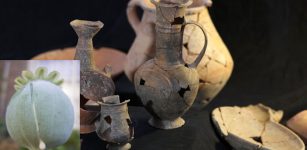 Opium Residue Discovered In 3,500-Year-Old Pottery Offers Evidence The Drug Was Used In Ancient Burial Rituals
Archaeology | Sep 20, 2022
Opium Residue Discovered In 3,500-Year-Old Pottery Offers Evidence The Drug Was Used In Ancient Burial Rituals
Archaeology | Sep 20, 2022 -
 On This Day In History: ‘Earl of Northumberland’ Thomas Percy Executed Because He Was Catholic – On August 22, 1572
News | Aug 22, 2016
On This Day In History: ‘Earl of Northumberland’ Thomas Percy Executed Because He Was Catholic – On August 22, 1572
News | Aug 22, 2016

